 |
GOTHIC ARCHITECTURE IN FRANCE:STRUCTURAL DEVELOPMENT |
| << GOTHIC ARCHITECTURE:STRUCTURAL PRINCIPLES, RIBBED VAULTING |
| GOTHIC ARCHITECTURE IN GREAT BRITAIN:GENERAL CHARACTER >> |
CHAPTER
XVI.
GOTHIC
ARCHITECTURE IN FRANCE.
BOOKS RECOMMENDED: As before, Adamy,
Corroyer, Enlart, Hasak,
Moore, Reber,
caract�res
de l'architecture fran�aise.
Davies, Architectural
Studies in France.
Ferree,
The
Chronology of the Cathedral
Churches of France.
Johnson, Early
French
Architecture.
King, The
Study book of Medi�val
Architecture and Art.
Lassus and
Viollet-le-Duc,
Notre
Dame de Paris.
Nesfield, Specimens
of Medi�val Architecture.
Pettit,
Architectural
Studies in France.
CATHEDRAL-BUILDING
IN FRANCE. In the
development of the principles
outlined
in the foregoing chapter the
church-builders of France led the way.
They
surpassed
all their contemporaries in readiness of
invention, in quickness and
directness
of reasoning, and in artistic refinement.
These qualities were
especially
manifested
in the extraordinary architectural
activity which marked the second
half
of
the twelfth century and the first half of the
thirteenth. This was the
great age of
cathedral-building
in France. The adhesion of the bishops to
the royal cause, and
their
position in popular estimation as the
champions of justice and human
rights,
led
to the rapid advance of the episcopacy in
power and influence. The cathedral,
as
the
throne-church of the bishop, became a
truly popular institution. New
cathedrals
were
founded on every side,
especially in the Royal Domain and the
adjoining
provinces
of Normandy, Burgundy, and Champagne, and their
construction was
warmly
seconded by the people, the communes, and
the municipalities. "Nothing to-
covered
Europe with railway lines,
can give an idea of the zeal
with which the urban
populations
set about building
cathedrals; . . . a necessity at the end
of the twelfth
century
because it was an energetic
protest against feudalism." The
collapse of the
unscientific
Romanesque vaulting of some of the
earlier cathedrals and the
destruction
by fire of others stimulated this
movement by the necessity for
their
immediate
rebuilding. The entire reconstruction of
the cathedrals of Bayeux,
Bayonne,
Cambray, Evreux, Laon,
Lisieux, Le Mans, Noyon, Poitiers,
Senlis,
Bourges,
Chartres, Paris, and Tours, and the abbey
of St. Denis, all of the
first
importance,
were begun during the same
period, and during the next
quarter-century
those
of Amiens, Auxerre, Rouen,
Reims, S�ez, and many others.
After 1250 the
movement
slackened and finally ceased. Few
important cathedrals were
erected
during
the latter half of the thirteenth century, the
chief among them being
at
Beauvais
(actively begun 1247), Clermont,
Coutances, Limoges, Narbonne,
and
Rodez.
During this period, and through the fourteenth and
fifteenth centuries,
French

architecture
was concerned rather with the
completion and remodelling of
existing
cathedrals
than the founding of new ones. There
were, however, many
important
parish
churches and civil or domestic
edifices erected within this
period.
STRUCTURAL
DEVELOPMENT: VAULTING. By the
middle of the twelfth century
the
use of barrel-vaulting over the
nave had been generally
abandoned and groined
vaulting
with its isolated points of
support and resistance had taken
its place. The
timid
experiments of the Clunisian architects
at V�zelay in the use of the
pointed
arch
and vault-ribs also led, in the
second half of the twelfth century, to
far-reaching
results.
The builders of the great Abbey
Church of
St.
Denis,
near Paris, begun in
1140
by the Abbot Suger, appear to
have been the first to
develop these
tentative
devices
into a system. In the original choir of
this noble church all the arches,
alike
of
the vault-ribs (except the groin-ribs,
which were semi-circles) and of the
openings,
were
pointed and the vaults were
throughout constructed with cross-ribs,
wall-ribs,
and
groin-ribs. Of this early work only the
chapels remain. In other
contemporary
monuments,
as for instance in the cathedral of Sens,
the adoption of these
devices
was
only partial and hesitating.
FIG.
116.--PLAN OF NOTRE DAME,
PARIS.
NOTRE
DAME AT PARIS. The next
great step in advance was
taken in the cathedral
Sully
in 1163, on the site of the twin cathedrals of
Ste. Marie and St. �tienne,
and
the
choir was, as usual, the
first portion erected. By 1196 the
choir, transepts, and
one
or two bays of the nave were
substantially finished. The completeness,
harmony,
and
vigor of conception of this remarkable
church contrast strikingly with
the
makeshifts
and hesitancy displayed in many
contemporary monuments in
other
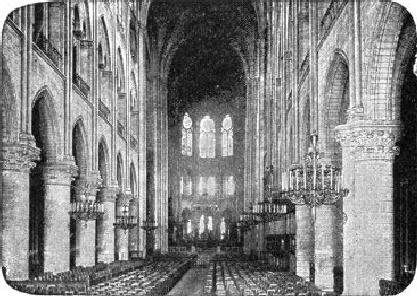
provinces.
The difficult vaulting over the
radiating bays of the double
ambulatory
was
here treated with great
elegance. By doubling the number of
supports in the
exterior
circuit of each aisle (Fig.
116) each trapezoidal bay of the
vaulting was
divided
into three easily managed
triangular compartments. Circular
shafts were used
between
the central and side aisles. The
side aisles were doubled and
those next the
centre
were built in two stories, providing
ample galleries behind a very
open
triforium.
The nave was unusually lofty and covered
with six-part vaults of
admirable
execution.
The vault-ribs were vigorously
moulded and each made to
spring from a
distinct
vaulting-shaft, of which three rested
upon the cap of each of the
massive
piers
below (Fig. 117). The Cathedral
of
Bourges,
begun 1190, closely
resembled
that
of Paris in plan. Both were
designed to accommodate vast
throngs in their
exceptionally
broad central aisles and
double side aisles, but
Bourges has no side-
aisle
galleries, though the inner aisles are
much loftier than the outer ones.
Though
later
in date the vaulting of Bourges is
inferior to that of Notre Dame,
especially in
the
treatment of the trapezoidal bays of the
ambulatory.
FIG.
117.--INTERIOR OF NOTRE DAME,
PARIS.
The
masterly examples set by the
vault-builders of St. Denis and
Notre Dame were
not
at once generally followed. Noyon,
Senlis, and Soissons, contemporary
with
these,
are far less completely
Gothic in style. At Le
Mans the
groined vaulting which
in
1158 was substituted for the original
barrel-vault of the cathedral is of
very
primitive
design, singularly heavy and
awkward, although nearly
contemporary with
that
of Notre Dame (Fig.
118).
DOMICAL
GROINED VAULTING. The
builders of the South and West,
influenced
by
Aquitanian models, adhered to the
square plan and domical form of
vaulting-bay,
even
after they had begun to employ
groin-ribs. The latter, as at first
used by them in
imitation
of Northern examples, had no organic function in the
vault, which was still
built
like a dome. About 11451160 the
cathedral of St.
Maurice at
Angers
was
vaulted
with square, groin-ribbed vaults,
domical in form but not in
construction.
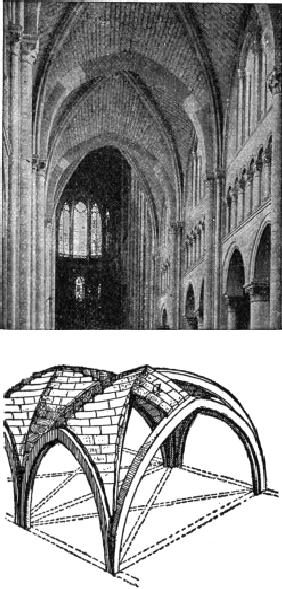
The
joints no longer described
horizontal circles as in a dome, but
oblique lines
perpendicular
to the groins and meeting in zigzag
lines at the ridge (Fig. 119).
This
method
became common in the West and
was afterward generally
adopted by the
English
architects. The Cathedrals
of
Poitiers
(1162) and
Laval
(La
Trinit�, 1180
1185)
are examples of this system, which at Le
Mans met with the Northern system
and
produced in the cathedral the awkward
compromise described
above.
FIG.
118.--LE MANS CATHEDRAL. NAVE.
FIG.
119.--GROINED VAULT WITH ZIG-ZAG
RIDGE-JOINTS.
a
shows
a small section of filling with
courses parallel to the
ridge, for comparison with
the
other compartments.
THIRTEENTH-CENTURY
VAULTING. Early
in the thirteenth century the
church-
builders
of Northern France abandoned the use of
square vaulting-bays and
six-part
vaults.
By the adoption of groin-ribs and the
pointed arch, the building of
vaults in
oblong
bays was greatly simplified.
Each bay of the nave could
now be covered with
its
own vaulting-bay, thus doing away with
all necessity for alternately light
and
heavy
piers. It is not quite certain when and
where this system was first
adopted for
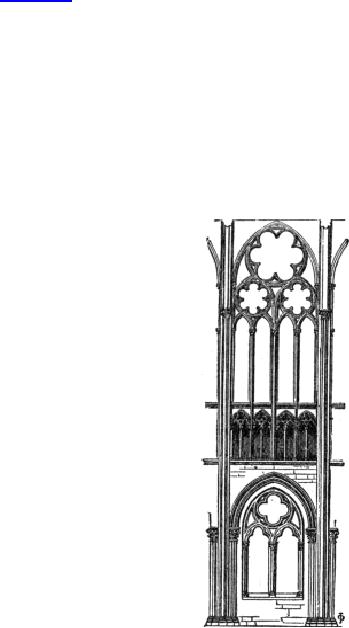
the
complete vaulting of a church. It
is, however, probable that the
Cathedral
of
Chartres,
begun in 1194 and completed before 1240,
deserves this distinction,
although
it is possible that the vaults of
Soissons and Noyon may slightly antedate
it.
Troyes
(11701267),
Rouen
(12021220),
Reims
(12121242),
Auxerre
(1215
1234,
nave fourteenth century),
Amiens
(12201288),
and nearly all the great
churches
and chapels begun after 1200,
employ the fully developed oblong
vault.
BUTTRESSING.
Meanwhile
the increasing height of the clearstories
and the use of
double
aisles compelled the bestowal of
especial attention upon the buttressing.
The
nave
and choir of Chartres, the choirs of
Notre Dame, Bourges, Rouen,
and Reims,
the
chevet and later the choir of
St. Denis, afford early
examples of the flying-
arches
spanned the side aisles; in
Notre Dame they crossed the
double aisles in a
single
leap. Later the buttresses
were given greater stability
by the added weight of
lofty
pinnacles. An intermediate range of
buttresses and pinnacles was built
over the
intermediate
piers where double aisles
flanked the nave and choir, thus
dividing the
single
flying arch into two arches. At the same
time a careful observation of
statical
defects
in the earlier examples led to the
introduction of subordinate arches and
of
other
devices to stiffen and to beautify the
whole system. At Reims
and
Amiens
these
features received their highest
development, though later examples
are
frequently
much more ornate.
FIG.
120.--ONE BAY, ABBEY OF ST.
DENIS.
INTERIOR
DESIGN. The
progressive change outlined in the
last chapter, by which
the
wall was practically suppressed, the
windows correspondingly enlarged,
and
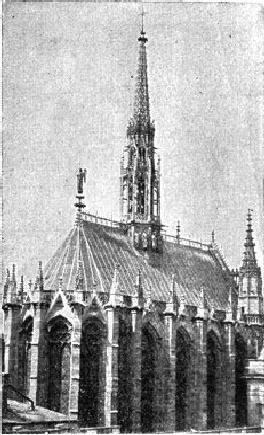
every
part of the structure made loftier and
more slender, resulted in the
evolution of
a
system of interior design well
represented by the nave of Amiens. The
second story
or
gallery over the side aisle
disappeared, but the aisle itself
was very high. The
triforium
was no longer a gallery, but a richly
arcaded passage in the thickness of
the
wall,
corresponding to the roofing-space over
the aisle, and generally treated
like a
lower
stage of the clearstory. Nearly the whole
space above it was occupied
in each
bay
by the vast clearstory window filled with
simple but effective geometric
tracery
over
slender mullions. The side
aisles were lighted by windows which,
like those in
the
clearstory, occupied nearly the whole
available wall-space under the vaulting.
The
piers
and shafts were all clustered and
remarkably slender. The whole
construction of
this
vast edifice, which covers
nearly eighty thousand
square feet, is a marvel
of
lightness,
of scientific combinations, and of fine
execution. Its great vault rises to
a
height
of one hundred and forty feet. The nave
of St. Denis, though less
lofty,
resembles
it closely in style (Fig. 120).
Earlier cathedrals show less of the
harmony of
proportion,
the perfect working out of the relation
of all parts of the composition of
each
bay, so conspicuous in the Amiens type,
which was followed in most of the
later
churches.
FIG.
121.--THE STE. CHAPELLE,
PARIS.
WINDOWS:
TRACERY. The
clearstory windows of Noyon, Soissons,
Sens, and the
choir
of V�zelay (1200) were simple
arched openings arranged
singly, in pairs, or in
threes.
In the cathedral of Chartres (11941220) they
consist of two arched
windows
with a circle above them, forming a
sort of plate tracery under a
single
arch.
In the chapel windows of the choir at
Reims (1215) the tracery of mullions
and
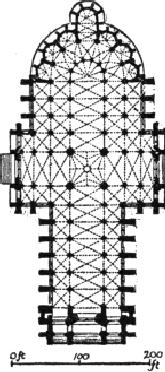
circles
was moulded inside and out, and the
intermediate triangular spaces
all
pierced
and glazed. Rose windows were
early used in front and transept
fa�ades.
During
the thirteenth and fourteenth centuries
they were made of vast size
and great
lightness
of tracery, as in the transepts of Notre
Dame (1257) and the west front of
Amiens
(1288). From the design of these windows
is derived the name Rayonnant,
often
applied to the French Gothic
style of the period 12751375.
THE
SAINTE CHAPELLE. In this
beautiful royal chapel at
Paris, built 124247,
Gothic
design was admirably
exemplified in the noble windows 15 by 50
feet in size,
which
perhaps furnished the models for
those of Amiens and St.
Denis. Each was
divided
by slender mullions into four lancet-like
lights gathered under the rich
tracery
of the window-head. They were filled with
stained glass of the most
brilliant
but
harmonious hues. They occupy the
whole available wall-space, so that the
ribbed
vault
internally seems almost to
rest on walls of glass, so
slender are the
visible
supports
and so effaced by the glow of color in
the windows. Certainly lightness
of
construction
and the suppression of the wall-masonry
could hardly be carried further
than
here (Fig. 121). Among other
chapels of the same type are
those in the palace of
St.
Germain-en-Laye (1240), and a later
example in the ch�teau of Vincennes,
begun
by
Charles VI., but not finished till
1525.
FIG.
122.--PLAN OF AMIENS
CATHEDRAL.
PLANS.
The
most radical change from the
primitive basilican type was, as
already
explained
in the last chapter, the continuation of
the side aisles around the
apse to
form
a chevet; and
later, the addition of chapels
between the external
buttresses.
Radiating
chapels, usually semi-octagons or
semi-decagons in plan, early appeared
as
additions
to the chevet
(Fig.
122). These may have originated in the
apsidal chapels
of
Romanesque churches in Auvergne and the
South, as at Issoire,
Clermont-Ferrand,
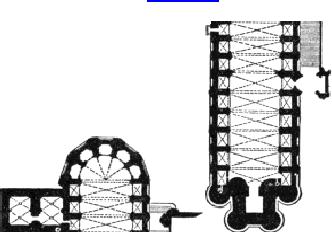
Le
Puy, and Toulouse. They generally
superseded the transept-chapels of
earlier
churches,
and added greatly to the beauty of the
interior perspective, especially
when
the
encircling aisles of the chevet
were doubled. Notre Dame, as
at first erected, had
a
double ambulatory, but no chapels.
Bourges has only five very
small semicircular
chapels.
Chartres (choir 1220) and Le Mans, as
reconstructed about the same
date,
have
double ambulatories and radial
chapels. After 1220 the second
ambulatory no
longer
appears. Noyon, Soissons, Reims,
Amiens, Troyes, and Beauvais,
Tours,
Bayeux,
and Coutances, Clermont, Limoges, and
Narbonne all have the
single
ambulatory
and radiating chevet-chapels. The
Lady-chapel in the axis of the
church
was
often made longer and more
important than the other chapels, as at
Amiens, Le
Mans,
Rouen, Bayeux, and Coutances.
Chapels also flanked the
choir in most of the
cathedrals
named above, and Notre Dame
and Tours also have side
chapels to the
nave.
The only cathedrals with complete double
side aisles alike to nave,
choir, and
chevet,
were Notre Dame and Bourges.
It is somewhat singular that the
German
cathedral
of Cologne is the only one in which all
these various characteristic
French
features
were united in one design
(see Fig.
140).
FIG.
123.--PLAN OF
CATHEDRAL
OF ALBY.
Local
considerations had full sway in France,
in spite of the tendency toward unity
of
type.
Thus Dol, Laon, and Poitiers have
square eastward terminations;
Ch�lons has
no
ambulatory; Bourges no transept. In
Notre Dame the transept was
almost
suppressed.
At Soissons one transept, at Noyon both,
had semicircular ends. Alby,
a
late cathedral of brick,
founded in 1280, but mostly built during the
fourteenth
century,
has neither side aisles nor
transepts, its wide nave
being flanked by
chapels
separated
by internal buttresses (Fig.
123).
SCALE.
The
French cathedrals were
nearly all of imposing dimensions. Noyon,
one
of
the smallest, is 333 feet long;
Sens measures 354. Laon,
Bourges, Troyes,
Notre
Dame,
Le Mans, Rouen, and Chartres vary from 396 to 437
feet in extreme
length;
Reims
measures 483, and Amiens, the longest of
all, 521 feet. Notre Dame is
124
feet
wide across the five aisles
of the nave; Bourges, somewhat wider. The
central
aisles
of these two cathedrals, and of Laon,
Amiens, and Beauvais, have a
span of not
far
from 40 feet from centre to centre of the
piers; while the ridge of the
vaulting,
which
in Notre Dame is 108 feet
above the pavement, and in Bourges 125,
reaches
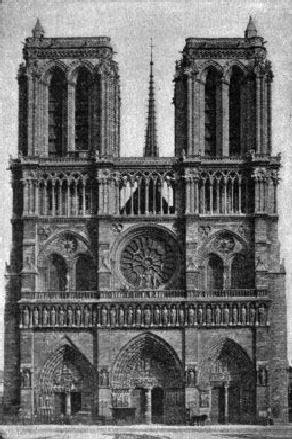
in
Amiens a height of 140 feet, and of
nearly 160 in Beauvais. This
emphasis of the
height,
from 3 to 3� times the clear width of the
nave or choir, is one of the
most
striking
features of the French cathedrals. It
produces an impressive effect, but
tends
to
dwarf the great width of the central
aisle.
FIG.
124.--WEST FRONT OF NOTRE DAME,
PARIS.
EXTERIOR
DESIGN. Here,
as in the interior, every feature had
its constructive
raison
d'�tre, and the
total effect was determined
by the fundamental structural
scheme.
This was especially true of the
lateral elevations, in which the
pinnacled
buttresses,
the flying arches, and the traceried
windows of the side aisle
and
clearstory,
repeated uniformly at each bay, were the
principal elements of the
design.
The
transept fa�ades and main front allowed
greater scope for invention and
fancy,
but
even here the interior
membering gave the key to the
composition. Strong
buttresses
marked the division of the aisles and
resisted the thrust of the
terminal
pier
arches, and rose windows filled the
greater part of the wall space under the
end
of
the lofty vaulting. The whole structure
was crowned by a steep-pitched
roof of
wood,
covered with lead, copper, or
tiles, to protect the vault from damage
by snow
and
moisture. This roof
occasioned the steep gables which
crowned the transept and
main
fa�ades. The main front was frequently
adorned, above the triple
portal, with a
gallery
of niches or tabernacles filled with
statues of kings. Different
types of
composition
are represented by Chartres,
Notre Dame, Amiens, Reims,
and Rouen, of
which
Notre Dame (Fig. 124) and
Reims are perhaps the
finest. Notre Dame is
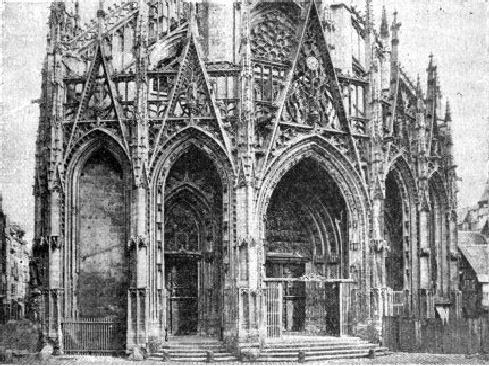
especially
remarkable for its stately
simplicity and the even balancing of
horizontal
and
vertical elements.
FIG.
125.--WEST FRONT OF ST.
MACLOU, ROUEN.
PORCHES.
In
most French church fa�ades the
porches were the most
striking
features,
with their deep shadows and sculptured
arches. The Romanesque
porches
were
usually limited in depth to the
thickness of the front wall. The Gothic
builders
secured
increased depth by projecting the
portals out beyond the wall, and
crowned
them
with elaborate gables. The vast
central door was divided in
two by a pier
adorned
with a niche and statue. Over this the tympanum of the
arch was carved
with
scriptural reliefs; the jambs and
arches were profusely
adorned with figures of
saints,
apostles, martyrs, and angels, under
elaborate canopies. The porches of
Laon,
Bourges,
Amiens, and Reims are
especially deep and majestic in
effect, the last-
named
(built 1380) being the richest of all.
Some of the transept fa�ades
also had
imposing
portals. Those of Chartres
(12101245)
rank among the finest works
of
Gothic
decorative architecture, the south
porch in some respects
surpassing that of
the
north transept. The portals of the
fifteenth and early sixteenth
centuries were
remarkable
for the extraordinary richness and
minuteness of their tracery and
sculpture,
as at Abbeville, Alen�on, the cathedral
and St. Maclou at Rouen
(Fig.
125),
Tours, Troyes, Vend�me,
etc.
TOWERS
AND SPIRES. The
emphasizing of vertical elements
reached its fullest
expression
in the towers and spires of the churches.
What had been at first merely
a
lofty
belfry roof was rapidly
developed into the spire, rising
three hundred feet or
more
into the air. This development had
already made progress in the
Romanesque
period,
and the south spire of Chartres is a
notable example of late
twelfth-century
steeple
design. The transition from the square
tower to the slender octagonal
pyramid
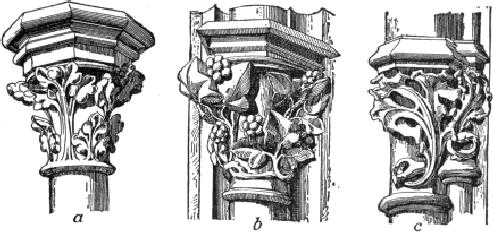
was
skilfully effected by means of corner
pinnacles and dormers. During and
after
the
thirteenth century the development
was almost wholly in the direction
of
richness
and complexity of detail, not of radical
constructive modification. The
northern
spire of Chartres (1515) and the spires
of Bordeaux, Coutances, Senlis,
and
the
Flamboyant church of St. Maclou at Rouen,
illustrate this development. In
Normandy
central spires were common,
rising over the crossing of
nave and
transepts.
In some cases the designers of
cathedrals contemplated a group of
towers;
this
is evident at Chartres, Coutances, and
Reims. This intention was,
however,
never
realized; it demanded resources
beyond even the enthusiasm of the
thirteenth
century.
Only in rare instances were the
spires of any of the towers completed,
and
the
majority of the French towers
have square terminations, with
low-pitched
wooden
roofs, generally invisible from
below. In general, French
towers are marked
by
their strong buttresses, solid
lower stories, twin windows in each
side of the
belfry
proper--these windows being usually of
great size--and a skilful
management
of
the transition to an octagonal plan for the
belfry or the spire.
CARVING
AND SCULPTURE. The
general superiority of French
Gothic work was
fully
maintained in its decorative
details. Especially fine is the
figure sculpture,
which
in the thirteenth and fourteenth
centuries attained true nobility of
expression,
combined
with great truthfulness and delicacy of
execution. Some of its
finest
productions
are found in the great doorway
jambs of the west portals of
the
cathedrals,
and in the ranks of throned and adoring
angels which adorned their
deep
arches.
These reach their highest
beauty in the portals of Reims (1380).
The
tabernacles
or
carved niches in which such
statues were set were
important elements
in
the decoration of the exteriors of
churches.
FIG.
126.--FRENCH GOTHIC
CAPITALS.
a,
From Sainte Chapelle, Paris,
13th century. b,
14th-century capital from
transept of
Notre
Dame, Paris. c,
15th-century capital from
north spire of
Chartres.
Foliage
forms were used for nearly
all the minor carved ornaments, though
grotesque
and
human figures sometimes took their
place. The gargoyles through which the
roof-
water
was discharged clear of the
building, were almost always
composed in the form
of
hideous monsters; and symbolic
beasts, like the oxen in the
towers of Laon, or
monsters
like those which peer from the
tower balustrades of Notre
Dame, were
employed
with some mystical significance in
various parts of the building. But
the
capitals
corbels, crockets, and finials
were mostly composed of
floral or foliage
forms.
Those of the twelfth and thirteenth
centuries were for the most part
simple in
mass,
and crisp and vigorous in design,
imitating the strong shoots of
early spring.
The
capitals
were
tall and slender, concave in profile,
with heavy square or
octagonal
abaci.
With the close of the thirteenth century
this simple and forcible style of
detail
disappeared.
The carving became more
realistic; the leaves, larger and
more mature,
were
treated as if applied to the capital or
moulding, not as if they grew out of
it.
The
execution and detail were
finer and more delicate, in harmony with
the
increasing
slenderness and lightness of the
architecture (Fig. 126 a,
b).
Tracery
forms
now
began to be profusely applied to all
manner of surfaces, and
open-work
gables,
wholly unnecessary from the structural point of view,
but highly effective as
decorations,
adorned the portals and crowned the
windows.
LATE
GOTHIC MONUMENTS. So far our
attention has been mainly
occupied with
the
masterpieces erected previous to 1250.
Among the cathedrals, relatively few
in
number,
whose construction is referable to the
second half of the century, that of
Beauvais
stands
first in importance. Designed on a
colossal scale, its
foundations
were
laid in 1225, but it was never
completed, and the portion built--the
choir and
chapels--belonged
really to the second half of the century,
having been completed
in
1270.
But the collapse in 1284 of the central
tower and vaulting of this
incomplete
cathedral,
owing to the excessive loftiness and
slenderness of its supports,
compelled
its
entire reconstruction, the number of the
piers being doubled and the
span of the
pier
arches correspondingly reduced. As thus
rebuilt, the cathedral aisle
was 47 feet
wide
from centre to centre of opposite
piers, and 163 feet high to the top of
the
vault.
Transepts were added after
1500. Limoges
and
Narbonne,
begun in 1272 on
a
large scale (though not
equal in size to Beauvais),
were likewise never
completed.
Both
had choirs of admirable plan, with
well-designed chevet-chapels. Many
other
cathedrals
begun during this period
were completed only after
long delays, as, for
instance,
Meaux, Rodez (1277), Toulouse (1272), and Alby (1282),
finished in the
sixteenth
century, and Clermont (1248), completed under
Napoleon III. But between
1260
or 1275 and 1350, work was actively
prosecuted on many still
incomplete
cathedrals.
The choirs of Beauvais (rebuilding),
Limoges, and Narbonne were
finished
after
1330; and towers, transept-fa�ades,
portals, and chapels added to many
others
of
earlier date.
The
style of this period is sometimes
designated as Rayonnant, from
the
characteristic
wheel tracery of the rose-windows, and
the prevalence of circular
forms
in
the lateral arched windows, of the
late thirteenth and early
fourteenth centuries.
The
great rose windows in the transepts of
Notre Dame, dating from 1257,
are
typical
examples of the style. Those of
Rouen cathedral belong to the
same category,
though
of later date. The fa�ade of
Amiens, completed by 1288, is one of the
finest
works
of this style, of which an early example
is the elaborate parish church of
St.
Urbain
at
Troyes.
THE
FLAMBOYANT STYLE. The
geometric treatment of the tracery and
the minute
and
profuse decoration of this period
gradually merged into the fantastic
and
unrestrained
extravagances of the Flamboyant
style,
which prevailed until the advent
of
the Renaissance--say 1525. The continuous
logical development of forms
ceased,
and
in its place caprice and
display controlled the arts of
design. The finest
monument
of this long period is the
fifteenth-century nave and central
tower of the
church
of St.
Ouen at
Rouen, a parish church of the first rank,
begun in 1318, but
not
finished until 1515. The tracery of the
lateral windows is still
chiefly geometric,
exhibit
in their tracery the florid decoration
and wavy, flame-like lines of this
style.
Slenderness
of supports and the suppression of
horizontal lines are here
carried to an
extreme;
and the church, in spite of its
great elegance of detail,
lacks the vital
interest
and charm of the earlier Gothic
churches. The cathedral of Alen�on and
the
church
of St.
Maclou at
Rouen, have portals with unusually
elaborate detail of
tracery
and carving; while the fa�ade of Rouen
cathedral (1509) surpasses all
other
examples
in the lace-like minuteness of its
open-work and its profusion of
ornament.
The
churches of St.
Jacques at
Dieppe, and of St.
Wulfrand at
Abbeville, the fa�ades
of
Tours and Troyes, are among the
masterpieces of the style. The upper part
of the
fa�ade
of Reims (13801428) belongs to the
transition from the Rayonnant to
the
Flamboyant.
While some works of this
period are conspicuous for the
richness of
their
ornamentation, others are
noticeably bare and poor in
design, like St. Merri
and
St.
S�verin in Paris.
SECULAR
AND MONASTIC ARCHITECTURE. The
building of cathedrals did not
absorb
all the architectural activity of the
French during the Gothic
period, nor did it
by
any means put an end to monastic
building. While there are
few Gothic cloisters
to
equal the Romanesque cloisters of
Puy-en-V�lay, Montmajour, Elne, and
Moissac,
many
of the abbeys either rebuilt their
churches in the Gothic style
after 1150, or
extended
and remodelled their conventual
buildings. The cloisters of
Fontfroide,
Chaise-Dieu,
and the Mont St. Michel rival those of
Romanesque times, while many
new
refectories and chapels were built in the
same style with the cathedrals.
The
most
complete of these Gothic
monastic establishments, that of the
Mont
St. Michel
in
Normandy, presented a remarkable
aggregation of buildings clustering
around the
steep
isolated rock on which stands the
abbey church. This was built in the
eleventh
century,
and the choir and chapels remodelled in
the sixteenth. The great
refectory
and
dormitory, the cloisters, lodgings, and
chapels, built in several vaulted
stories
against
the cliffs, are admirable
examples of the vigorous pointed-arch
design of the
early
thirteenth century.
Hospitals
like
that of St. Jean at Angers
(late twelfth century), or those of
Chartres,
Ourscamps,
Tonnerre, and Beaune, illustrate how
skilfully the French could modify
and
adapt the details of their architecture
to the special requirements of
civil
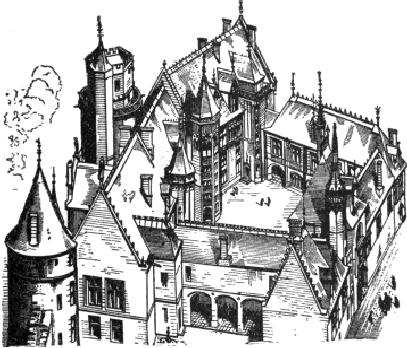
architecture.
Great numbers of charitable
institutions were built in the middle
ages--
asylums,
hospitals, refuges, and the like--but very few of
those in France are
now
extant.
Town halls were built in the fifteenth
century in some places where a
certain
amount
of popular independence had been
secured. The florid
fifteenth-century
Palais
de Justice at
Rouen
(14991508)
is an example of another branch of
secular
Gothic
architecture. In all these monuments the
adaptation of means to ends
is
admirable.
Wooden ceilings and roofs
replaced stone, wherever
required by great
width
of span or economy of construction.
There was little sculpture; the
wall-spaces
were
not suppressed in favor of stained
glass and tracery; while the roofs
were
usually
emphasized and adorned with elaborate
crestings and finials in lead or
terra-
cotta.
DOMESTIC
ARCHITECTURE. These
same principles controlled the
designing of
houses,
farm buildings, barns, granaries, and the
like. The common
closely-built
French
city house of the twelfth and thirteenth
century is illustrated by many
extant
examples
at Cluny, Provins, and other towns. A
shop opening on the street by a
large
arch,
a narrow stairway, and two or three
stories of rooms lighted by
clustered,
pointed-arched
windows, constituted the common
type. The street front was
usually
gabled
and the roof steep. In the fourteenth or
fifteenth century half-timbered
construction
began to supersede stone for town
houses, as it permitted of
encroaching
upon the street by projecting the upper
stories. Many of the half-
timbered
houses of the fifteenth century were of
elaborate design. The heavy
oaken
uprights
were carved with slender
colonnettes; the horizontal sills,
bracketed out
over
the street, were richly moulded;
picturesque dormers broke the
sky-line, and the
masonry
filling between the beams
was frequently faced with
enamelled tiles.
FIG.
127.--HOUSE OF JACQUES COEUR,
BOURGES.
(After
Viollet-le-Duc.)
The
more considerable houses or
palaces of royalty, nobles, and wealthy
citizens
rivalled,
and in time surpassed, the monastic
buildings in richness and splendor.
The
earlier
examples retain the military
aspect, with moat and donjon, as in the
Louvre of
Charles
V., demolished in the sixteenth century. The
finest palaces are of late
date,
and
the type is well represented by the Ducal
Palace at Nancy (1476), the Hotel
de
Cluny
(1485) at
Paris, the Hotel
Jacques Coeur at
Bourges (Fig. 127), and the
east
wing
of Blois (14981515). These palaces
are not only excellently and
liberally
planned,
with large halls, many staircases, and
handsome courts; they are
also
extremely
picturesque with their square and
circular towers, slender
turrets,
elaborate
dormers, and rich carved
detail.
MONUMENTS:
(C. = cathedral; A. = abbey;
trans. = transept; each
edifice is given
under
the date of its
commencement; subsequent alterations in
parentheses.) Between
1130
and 1200: V�zelay A.,
ante-chapel, 1130; St. Germer-de-Fly
C., 11301150
(chapel
later); St. Denis A.,
choir, 1140 (choir rebuilt,
nave and trans., 1240);
Sens C.,
114068
(W. front, 13th century;
chapels, spire, 14th);
Senlis C., 114583
(trans.,
spire,
13th century); Noyon C., 11491200
(W. front, vaults, 13th
century); St.
Germain-des-Pr�s
A., Paris, choir, 1150
(Romanesque nave); Angers
C., 1150 (choir,
trans.,
1274); Langres, 11501200; Laon
C., 11501200; Le Mans C.,
nave, 115058
(choir,
121754); Soissons C., 116070
(choir, 1212; nave chapels, 14th
century);
Poitiers
C., 11621204; Notre Dame,
Paris, choir, 116396 (nave, W.
front finished,
1235;
trans. fronts, and chapels,
125775); Chartres C., W. end, 1170;
rest, mainly
119498
(trans. porches, W. rose, 12101260;
N. spire, 1506); Tours C.,
1170
(rebuilt,
1267; trans., portals, 1375; W. portals,
chapels, 15th century; towers
finished,
150747);
Laval C., 118085 (choir, 16th
century); Mantes, church
Notre Dame,
11801200;
Bourges C., 119095 (E.
end, 1210; W. end, 1275);
St. Nicholas at Caen,
1190
(vaults, 15th century); Reims,
church St. R�my, choir,
end of 12th century
(Romanesque
nave); church St. Leu
d'Esserent, choir late 12th
century (nave, 13th
century);
Lyons C., choir, end of 12th
century (nave, 13th and 14th
centuries); Etampes,
church
Notre Dame, 12th and 13th
centuries.--13th century: Evreux
C., 120275
(trans.,
central tower, 1417; W. front
rebuilt, 16th century); Rouen
C., 120220 (trans.
portals,
1280; W. front, 1507); Nevers, 1211, N.
portal, 1280 (chapels, S. portal,
15th
century);
Reims C., 121242 (W.
front, 1380; W. towers, 1420);
Bayonne C., 1213
(nave,
vaults, W. portal, 14th century);
Troyes C., choir, 1214
(central tower, nave,
W.
portal, and towers, 15th
century); Auxerre C., 121534
(nave, W. end, trans.,
14th
century);
Amiens C., 122088; St.
Etienne at Chalons-sur-Marne, 1230
(spire, 1520);
S�ez
C., 1230, rebuilt 1260 (remodelled 14th
century); Notre Dame de
Dijon, 1230;
Reims,
Lady chapel of Archbishop's
palace, 1230; Chapel Royal at
St. Germain-en-Laye,
1240;
Ste. Chapelle at Paris, 124247
(W. rose, 15th century);
Coutances C., 125474;
Beauvais
C., 124772 (rebuilt 133747;
trans. portals, 150048); Notre
Dame de
Grace
at Clermont, 1248 (finished 1350); D�l
C., 13th century; St.
Martin-des-Champs
at
Paris, nave 13th century
(choir Romanesque); Bordeaux
C., 1260; Narbonne
C.,
12721320;
Limoges, 1273 (finished 16th century);
St. Urbain, Troyes,
1264;
Rodez
C., 12771385 (altered, completed
16th century); church St.
Quentin, 1280
1300;
St. Benigne at Dijon, 128091;
Alby C., 1282 (nave, 14th;
choir, 15th century;
S.
portal, 14731500); Meaux C.,
mainly rebuilt 1284 (W. end
much altered 15th,
finished
16th century); Cahors C.,
rebuilt 128593 (W. front, 15th
century); Orl�ans,
12871328
(burned, rebuilt 16011829).--14th
century: St. Bertrand de
Comminges,

130450;
St. Nazaire at Carcassonne,
choir and trans. on
Romanesque nave;
Montpellier
C., 1364; St. Ouen at Rouen,
choir, 131839 (trans., 140039;
nave,
146491;
W. front, 1515); Royal
Chapel at Vincennes, 1385 (?)-1525.--15th
and 16th
century:
St. Nizier at Lyons rebuilt;
St. S�verin, St. Merri,
St. Germain l'Auxerrois, all
at
Paris;
Notre Dame de l'Epine at
Chalons-sur-Marne; choir of St.
Etienne at Beauvais;
Saintes
C., rebuilt, 1450; St.
Maclou at Rouen (finished 16th
century); church at
Brou;
St.
Wulfrand at Abbeville; abbey of
St. Riquier--these three all
early 16th century.--
HOUSES,
CASTLES,
AND
PALACES:
Bishop's palace at Paris, 1160
(demolished); castle of
Coucy,
122030; Louvre at Paris (the
original ch�teau), 12251350; Palais
de Justice at
Paris,
originally the royal
residence, 12251400; Bishop's palace
at Laon, 1245
(addition
to Romanesque hall); castle
Montargis, 13th century; castle
Pierrefonds,
Bishop's
palace at Narbonnne, palace of
Popes at Avignon--all 14th century;
donjon of
palace
at Poitiers, 1395; H�tel des
Ambassadeurs at Dijon, 1420; house of
Jacques Coeur
at
Bourges, 1443; Palace, Dijon, 1467;
Ducal palace at Nancy, 1476;
H�tel Cluny at
Paris,
1490; castle of Creil, late 15th
century, finished in 16th; E. wing
palace of Blois,
14981515,
for Louis XII.; Palace de
Justice at Rouen, 14991508.
CATH�DRALE,
CHAPELLE,
CONSTRUCTION,
�GLISE,
MAISON,
VO�TE.
21.
Dictionnaire
raisonn� de l'architecture
fran�aise,
vol. ii., pp. 280, 281.
22.
See
Ferree, Chronology
of Cathedral Churches of
France.
23.
This
cathedral will be hereafter referred to,
for the sake of brevity, by
the name
of
Notre
Dame.
Other cathedrals having the
same name will be distinguished by
the
addition
of the name of the city, as
"Notre Dame at Clermont-Ferrand."
Table of Contents:
- PRIMITIVE AND PREHISTORIC ARCHITECTURE:EARLY BEGINNINGS
- EGYPTIAN ARCHITECTURE:LAND AND PEOPLE, THE MIDDLE EMPIRE
- EGYPTIAN ARCHITECTURE—Continued:TEMPLES, CAPITALS
- CHALDÆAN AND ASSYRIAN ARCHITECTURE:ORNAMENT, MONUMENTS
- PERSIAN, LYCIAN AND JEWISH ARCHITECTURE:Jehovah
- GREEK ARCHITECTURE:GENERAL CONSIDERATIONS, THE DORIC
- GREEK ARCHITECTURE—Continued:ARCHAIC PERIOD, THE TRANSITION
- ROMAN ARCHITECTURE:LAND AND PEOPLE, GREEK INFLUENCE
- ROMAN ARCHITECTURE—Continued:IMPERIAL ARCHITECTURE
- EARLY CHRISTIAN ARCHITECTURE:INTRODUCTORY, RAVENNA
- BYZANTINE ARCHITECTURE:DOMES, DECORATION, CARVED DETAILS
- SASSANIAN AND MOHAMMEDAN ARCHITECTURE:ARABIC ARCHITECTURE
- EARLY MEDIÆVAL ARCHITECTURE:LOMBARD STYLE, FLORENCE
- EARLY MEDIÆVAL ARCHITECTURE.—Continued:EARLY CHURCHES, GREAT BRITAIN
- GOTHIC ARCHITECTURE:STRUCTURAL PRINCIPLES, RIBBED VAULTING
- GOTHIC ARCHITECTURE IN FRANCE:STRUCTURAL DEVELOPMENT
- GOTHIC ARCHITECTURE IN GREAT BRITAIN:GENERAL CHARACTER
- GOTHIC ARCHITECTURE IN GERMANY, THE NETHERLANDS, AND SPAIN
- GOTHIC ARCHITECTURE IN ITALY:CLIMATE AND TRADITION, EARLY BUILDINGS.
- EARLY RENAISSANCE ARCHITECTURE IN ITALY:THE CLASSIC REVIVAL, PERIODS
- RENAISSANCE ARCHITECTURE IN ITALY—Continued:BRAMANTE’S WORKS
- RENAISSANCE ARCHITECTURE IN FRANCE:THE TRANSITION, CHURCHES
- RENAISSANCE ARCHITECTURE IN GREAT BRITAIN AND THE NETHERLANDS
- RENAISSANCE ARCHITECTURE IN GERMANY, SPAIN, AND PORTUGAL
- THE CLASSIC REVIVALS IN EUROPE:THE EIGHTEENTH CENTURY
- RECENT ARCHITECTURE IN EUROPE:MODERN CONDITIONS, FRANCE
- ARCHITECTURE IN THE UNITED STATES:GENERAL REMARKS, DWELLINGS
- ORIENTAL ARCHITECTURE:INTRODUCTORY NOTE, CHINESE ARCHITECTURE
- APPENDIX.